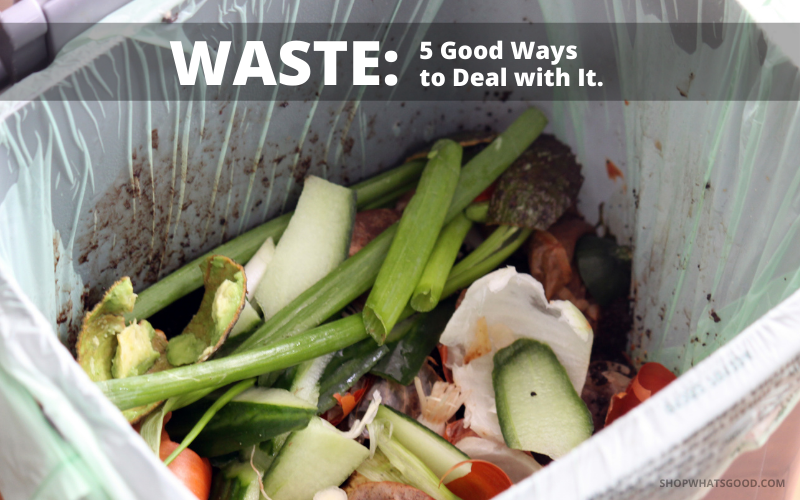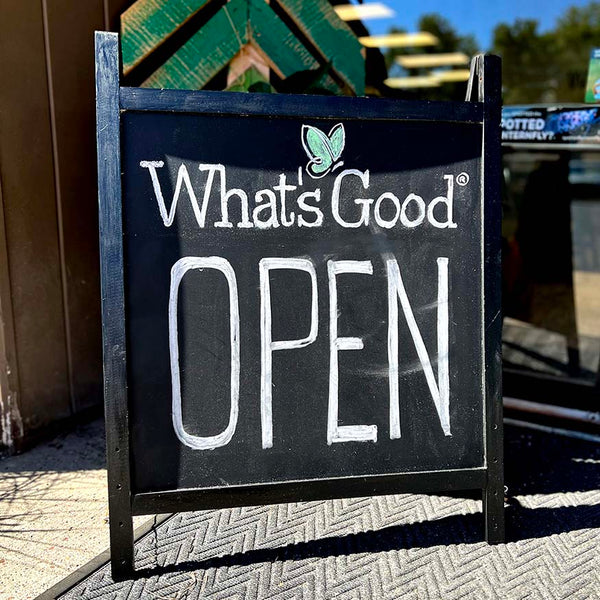FREE 🇺🇸 GROUND SHIPPING Orders 75+
FREE 🇺🇸 GROUND SHIPPING Orders 75+
Add description, images, menus and links to your mega menu
A column with no settings can be used as a spacer
Link to your collections, sales and even external links
Add up to five columns
Add description, images, menus and links to your mega menu
A column with no settings can be used as a spacer
Link to your collections, sales and even external links
Add up to five columns
Food Waste
November 11, 2021

WASTE: 5 Good Ways to Deal with It.
By Stephanie Bowen
Like most people, I love food. I crave the satisfaction of a perfectly balanced stew warming my belly on a cold winter’s night, or a fresh summer salad that awakens my senses with every bite. But it’s more than just eating good food that keeps my pilot light lit; it is everything associated with it: picking out local produce at the farmer’s market, growing fresh herbs in the summer, finding—or creating—a new recipe. I fancy roaming the aisles of the behemoth Wegmans down the street and delight in discovering a specialty spice shop tucked away in a far-off neighborhood. Heck, I don’t even mind hand-washing greasy pans or emptying the dishwasher.
But there is one thing I hate about food: wasting it. Just ask my husband—he will confirm that I absolutely abhor food waste. He might even tell you how many times I insisted we eat leftovers or found some new way to use every single bit of that rotisserie chicken (minimally, I get three delicious meals, plus lots of treats for our dog Pepper).
Growing up, food waste bothered me because it squandered money, made the trash and refrigerator smell bad, and delivered a huge helping of guilt knowing that many people around the world didn’t have access to the abundance and quality of food that I have always enjoyed. As I became more conscious about how it contributed to climate change, I had another reason to hate—and feel guilty about—food waste.
So, just how does wasting food impact our climate and the overall health of the environment? I’m glad you asked! According to the recent World Wildlife Fund (WWF) report, Driven to Waste: The Global Impact of Food Loss and Waste on Farms, 2.5 billon tons of food goes uneaten around the world every year. That’s a whopping 40% of the food that is produced. Imagine all the land, water and energy it takes to produce that food. Let’s focus on the energy.
From growing, transporting, processing and handling food, it takes a lot of energy to get a bag of salad, pound of cheese, or special cut of prime rib from farm to table. In the U.S. alone, food production accounts for a full 10% of all energy used. Think about that for a minute. Of the gazillion things that we do that use energy, food production accounts for 10%! And unfortunately, that process uses mostly energy from non-renewable fossil fuels, which emit greenhouse gasses like carbon dioxide, accelerating climate change.
But it’s not just the production process that is a problem. When you throw that rotten potato in the trash, it, along with all the other food that ends up in our landfills, emits methane, another greenhouse gas. According to the Pew Charitable Trusts, food waste in landfills has tripled since the 1960s and produced tons of greenhouse gases, which again, accelerate climate change.
Is that enough to make you pare down your shopping list to just the essentials or throw that crust of bread into the freezer until you’re ready to make croutons? Personally, I’m always looking for ways to make sure that the food I purchase lasts as long as it can or gets used in new ways. By properly storing food in right breathable or airtight containers, you can make your food last longer. What’s Good’s food storage products are extensive, impressive and guilt free! Like these Food Huggers that cover open cans, halved fruit and other small items, or these chemical-free Stand Up Silicone Bags that reseal and work in the freezer, refrigerator or microwave.
But what do you do if your baby spinach starts to wilt? Throw it in a smoothie before you throw it in the trash—your body and your soul will thank you. For me, it’s always the end of the bread loaf that causes angst. We just can’t seem to use up our bread before it starts to harden, and I’ll be honest, I’m not one to make croutons. Then one day I turned to my trusted resource for all quandaries in life: Google. A simple search of “how to use stale bread” brought up so many fabulous recipes for the traditional Italian bread salad Panzanella, that it’s now a staple in our home.
Shopping for what you need, storing your food better and using all your food up in create ways are just some of the ways you can cut down on your food waste. But there will always be a little bit of waste—the tomato stem, the carrot in the back of the fridge that didn’t make it into the cake before going moldy, etc.—which is where composting comes in!
With growing awareness of the dangers of food waste, and some new laws to discourage it, more people are turning to composting. Whether using an at-home composting system—check out this attractive counter-top composter from What’s Good—or a community-based compost service, composting is a great way to turn your food waste into something useful. But it’s not just food waste that can be composted. From cling wrap to disposable cups and plates and so much more, What’s Good has a whole host of items to help you reduce your waste and just focus on the pleasures of food. And if you were curious like me, putting scraps down the garbage disposal is slightly better than the landfill, but composting is your best bet.
One final tip to reduce the harmful effects of food waste: eat less meat. Fewer cows grazing the land means less methane being released to the atmosphere (did someone say fart?). Farming meat and animal products accounts for 40% of the farm-related greenhouse gas emissions. Not ready to give up meat completely? Me either. Start with Meatless Monday and see how it feels, or make sure your meat is from a local, sustainably produced farm.
I hope you feel inspired and equipped to cut down on food waste! And remember, the point is not to feel overwhelmed with all of the ways you can be a better steward of the planet, but to pick the ones that are most doable until you’re ready to add more. It will take all of us doing something to create the world we want to live in.
Do you have a favorite recipe that helps you reduce your food waste? Maybe a vegan specialty that will keep even meatiest-of-eaters satisfied? Or some other trick you want to share? Drop a line in the comments section! Or feel free to ask any questions I didn’t answer. What’s Good wants to be your resource for all things eco, no matter what your shade of green!

About Stephanie Bowen: After two successful careers —one in broadcast journalism, another as a communications and PR pro working in global health, development and rights — Stephanie is harnessing her love of story and strategic communications for positive impact with the consultancy practice, SHARE: Stories that Buzz. She is a contributor, sounding board, friend, and customer of What's Good.
Keywords: Food waste, compost, food storage, plastic-free, greenhouse gas, climate change, landfills, meat-free, eco-friendly, leftovers
Leave a comment

Good News
If any email is worthy of your inbox, it's this. Our goal is 1–2x per month. You'll get helpful & inspiring eco info, plus subscriber-only discounts.
Welcome to What's Good
Here's your $10 coupon
COPY THIS CODE TO USE IN CHECKOUT
